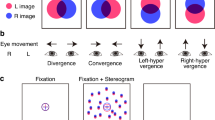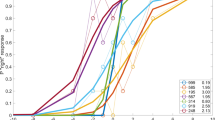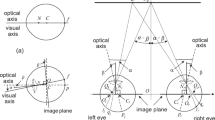Abstract
TO calculate the depth difference between a pair of points on a three-dimensional surface from binocular disparities, it is necessary to know the absolute distance to the surface1,2. Traditionally, it has been assumed that this information is derived from non-visual sources such as the vergence angle of the eyes3,4. It has been shown5,6 that the horizontal gradient of vertical disparity between the images in the two eyes also contains information about the fixation distance7–9. Recent results10,11, however, indicated that manipulations of the vertical disparity gradient have no effect on either the perceived shape or the perceived depth of surfaces defined by horizontal disparities. Following the reasoning of Longuet-Higgins12 and Tyler13, we suggest that vertical disparities are best understood as a consequence of perspective viewing from two different vantage points and the results we report here show that the human visual system is able to exploit vertical disparities and use them to scale the perceived depth and size of stereoscopic surfaces, if the field of view is sufficiently large.
This is a preview of subscription content, access via your institution
Access options
Subscribe to this journal
Receive 51 print issues and online access
$199.00 per year
only $3.90 per issue
Buy this article
- Purchase on SpringerLink
- Instant access to full article PDF
Prices may be subject to local taxes which are calculated during checkout
Similar content being viewed by others
References
Ono, H. & Comerford, J. Stability and Constancy in Visual Perception (ed. Epstein, W.) 91–128 (Wiley, New York, 1977).
Bishop, P. O. Proc. R. Soc. B237, 445–469 (1989).
Helmholtz, H. von Treatise on Ophysiological Ptics Vol. III (Dover, New York, 1925).
Foley, J. M. Psychol. Rev. 87, 411–434 (1980).
Mayhew, J. E. W. & Longuet-Higgins, H. C. Nature 297, 376–378 (1982).
Mayhew, J. E. W. Perception 11, 387–483 (1982).
Koenderink, J. J. & van Doorn, A. J. Biol. Cybernetics 21, 29–35 (1976).
Porrill, J. Mayhew, J. E. W. & Frisby, J. Frontiers of Visual Science: Proc. 1985 Symp. 90–108 (National Academy, Washington. 1987)
Petrov, A. P. Vision Res. 20, 409–416 (1980).
Cumming, B. G., Johnston, E. B. & Parker, A. J. Nature 349, 411–413 (1991).
Sobel, E. C. & Collett, T. S. Proc. R. Soc B244, 87–90 (1991).
Longuet-Higgins, H. C. Nature 293, 133–135 (1981).
Tyler, C. W. Binocular Vision (ed. Regan, D.) 19–37 (Macmillan, London, 1991).
Howard, I. P. Psychon. Monogr. 3, suppl 201–219 (1970).
Frisby, J. P. Nature 307, 592–593 (1984).
Stenton, S. P., Frisby, J. P. & Mayhew, J. E. W. Nature 309, 622–623 (1984).
Rogers, B. J. & Bradshaw, M. F. Invest. Opthalmol. Vis. Sci. 33, 1333 (1992).
Rogers, B. J., Bradshaw, M. F., Glennerster, A. & De Bruyn, B. Perception 21, (suppl.), 18 (1992).
Author information
Authors and Affiliations
Rights and permissions
About this article
Cite this article
Rogers, B., Bradshaw, M. Vertical disparities, differential perspective and binocular stereopsis . Nature 361, 253–255 (1993). https://doi.org/10.1038/361253a0
Received:
Accepted:
Published:
Issue date:
DOI: https://doi.org/10.1038/361253a0
This article is cited by
-
Depth and direction effects in the prediction of static and shifted reaching goals from kinematics
Scientific Reports (2023)
-
Do observers use their own interpupillary distance in disparity scaling?
Optical Review (2023)
-
Some binocular advantages for planning reach, but not grasp, components of prehension
Experimental Brain Research (2019)
-
Geological interpretation of two virtual outcrops of deformed Palaeozoic rocks (NW Iberian Peninsula) using 3D stereo VDT in a computer assisted virtual environment (CAVE™)
Journal of Iberian Geology (2019)



